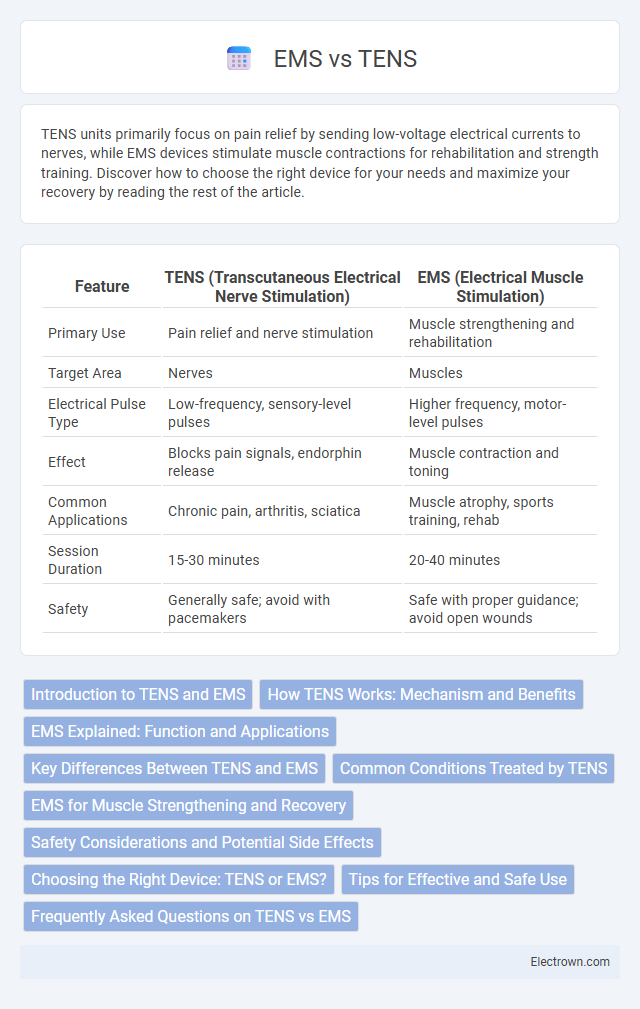TENS units primarily focus on pain relief by sending low-voltage electrical currents to nerves, while EMS devices stimulate muscle contractions for rehabilitation and strength training. Discover how to choose the right device for your needs and maximize your recovery by reading the rest of the article.
Table of Comparison
| Feature | TENS (Transcutaneous Electrical Nerve Stimulation) | EMS (Electrical Muscle Stimulation) |
|---|---|---|
| Primary Use | Pain relief and nerve stimulation | Muscle strengthening and rehabilitation |
| Target Area | Nerves | Muscles |
| Electrical Pulse Type | Low-frequency, sensory-level pulses | Higher frequency, motor-level pulses |
| Effect | Blocks pain signals, endorphin release | Muscle contraction and toning |
| Common Applications | Chronic pain, arthritis, sciatica | Muscle atrophy, sports training, rehab |
| Session Duration | 15-30 minutes | 20-40 minutes |
| Safety | Generally safe; avoid with pacemakers | Safe with proper guidance; avoid open wounds |
Introduction to TENS and EMS
TENS (Transcutaneous Electrical Nerve Stimulation) and EMS (Electrical Muscle Stimulation) are two types of electrotherapy used for pain relief and muscle rehabilitation. TENS targets sensory nerves to reduce pain signals, while EMS stimulates motor nerves to elicit muscle contractions for strengthening and recovery. Both devices deliver electrical pulses through electrodes placed on the skin but serve distinct therapeutic purposes.
How TENS Works: Mechanism and Benefits
TENS (Transcutaneous Electrical Nerve Stimulation) works by delivering low-voltage electrical currents through the skin to stimulate nerve fibers, which helps block pain signals from reaching the brain and promotes the release of endorphins. This mechanism provides effective pain relief for conditions like arthritis, back pain, and neuropathy without the side effects of medication. Your experience with TENS can include reduced muscle spasms and improved mobility, making it a valuable tool for managing chronic and acute pain symptoms.
EMS Explained: Function and Applications
Electrical Muscle Stimulation (EMS) works by sending electrical impulses to muscles, causing involuntary contractions to improve strength, endurance, and recovery. EMS is extensively used in physical therapy, athletic training, and rehabilitation to enhance muscle performance and prevent atrophy. This technology targets motor neurons directly, differentiating it from TENS, which focuses on pain relief by stimulating sensory nerves.
Key Differences Between TENS and EMS
TENS (Transcutaneous Electrical Nerve Stimulation) primarily targets pain relief by stimulating sensory nerves, while EMS (Electrical Muscle Stimulation) focuses on muscle contraction and strengthening through motor nerve activation. The electrical pulse intensity and frequency differ significantly, with TENS employing lower frequencies to block pain signals and EMS using higher frequencies to induce muscle movements. Understanding these key differences helps you choose the appropriate therapy for either managing chronic pain or enhancing muscle rehabilitation and fitness.
Common Conditions Treated by TENS
TENS (Transcutaneous Electrical Nerve Stimulation) is commonly used to treat chronic pain conditions such as arthritis, sciatica, and neuropathy by blocking pain signals to the brain and stimulating endorphin production. It is also effective for acute pain relief from injuries, postoperative pain, and muscle strains. Your healthcare provider can help determine if TENS therapy is suitable for managing your specific pain symptoms.
EMS for Muscle Strengthening and Recovery
EMS (Electrical Muscle Stimulation) effectively promotes muscle strengthening and accelerates recovery by delivering electrical impulses that cause muscle contractions, enhancing muscle fiber recruitment beyond voluntary efforts. It supports rehabilitation by reducing muscle atrophy and improving circulation, which facilitates faster healing of musculoskeletal injuries. Clinical studies demonstrate EMS's benefits in increasing muscle mass and functional performance, making it a valuable tool for athletes and patients recovering from surgeries.
Safety Considerations and Potential Side Effects
TENS (Transcutaneous Electrical Nerve Stimulation) and EMS (Electrical Muscle Stimulation) differ in safety profiles, with TENS primarily targeting nerve pathways to relieve pain, presenting minimal risks when used as directed, while EMS stimulates muscle contractions and requires careful intensity management to avoid muscle strain or skin irritation. Both modalities may cause mild side effects such as skin redness, itching, or discomfort at electrode sites, with contraindications including pacemakers, pregnancy, and certain neurological conditions. Proper device usage, adherence to manufacturer guidelines, and consultation with healthcare professionals minimize risks and enhance safety during TENS or EMS therapy.
Choosing the Right Device: TENS or EMS?
Choosing between TENS (Transcutaneous Electrical Nerve Stimulation) and EMS (Electrical Muscle Stimulation) depends on treatment goals--TENS targets pain relief by stimulating sensory nerves, while EMS focuses on muscle strengthening and rehabilitation through muscle contractions. For chronic pain management, TENS devices with adjustable frequency and intensity settings offer customizable relief, whereas EMS devices are preferred for muscle recovery and improving circulation. Evaluating specific medical conditions and consulting healthcare professionals ensure optimal selection tailored to individual therapy needs.
Tips for Effective and Safe Use
To ensure safe and effective use of TENS and EMS devices, always follow the manufacturer's guidelines and consult a healthcare professional before starting treatment. Use electrodes on clean, dry skin and avoid placing them over broken skin, the chest, or near the heart to prevent adverse effects. Adjust the intensity gradually to a comfortable level, monitor your skin for irritation, and discontinue use if you experience pain or discomfort during your therapy sessions.
Frequently Asked Questions on TENS vs EMS
TENS (Transcutaneous Electrical Nerve Stimulation) is primarily used for pain relief by sending low-voltage electrical pulses to nerves, while EMS (Electrical Muscle Stimulation) targets muscle contraction to improve strength and recovery. Frequently asked questions often address differences in usage, with TENS favored for chronic pain management and EMS commonly applied in physical therapy and muscle rehabilitation. Understanding electrode placement, pulse frequency, and intensity settings is crucial for maximizing the benefits of both TENS and EMS devices.
TENS vs EMS Infographic

 electrown.com
electrown.com